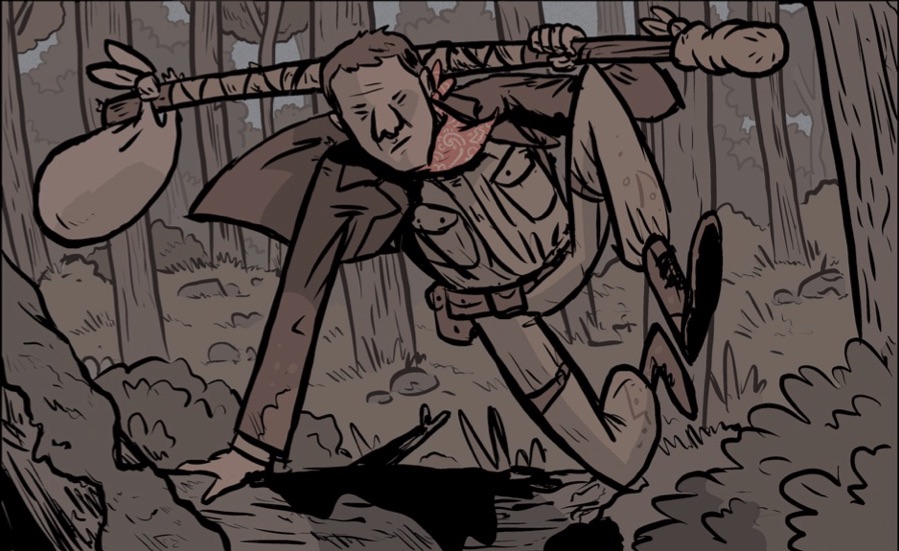
Rock Candy Mountain Vol. 1 comes out September 27, collecting issues #1-#4 of this Image Comics hobo epic. I chatted with writer/artist Kyle Starks about the book, what inspired him to write it, how the devil got involved, and more. Read on for the full transcript of our phone call!
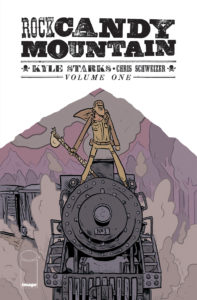 Rogues Portal: Thanks for taking the time to chat, Kyle! I really appreciate it. How was GenCon?
Rogues Portal: Thanks for taking the time to chat, Kyle! I really appreciate it. How was GenCon?
Kyle Starks: It was a board game convention, so sort of weird and great but not really a money-making venture. It was like a working vacation, sort of. For Oni Press I just did a book based on a very popular board game so we were promoting that. It’s called Dead of Winter. I went last year to promote Rick and Morty; I’m the ongoing writer and occasional artist and I was like, “man, board games, no thank you.” But I ended up playing Dead of Winter because coincidentally they had a plot to get me to write this book anyway. I follow a lot of board games now and that game in particular, which was kind of fortuitous.
RP: The most obvious influence for this comic is the song “Big Rock Candy Mountain”, but there are also a lot of other elements in play, including the literal devil. How did you come up with this story?
KS: My first book, period, was Sexcastle. It was an homage to 80s action films. I love action movies. I’m a big action movie guy. I decided to sort of venture into martial arts cinema because I felt like it’s something that clearly would interest me; it has a lot of the same plot points and basic story structure. That is daunting and challenging. There’s so much. The genre is huge.
Going down the “Top 10 Kung Fu Movies You Should Watch” or whatever, several of them are a genre called wuxia. This is a very specific kind of story that doesn’t exist in America, and I became more fascinated with this than with other kung fu movies. Wuxia movies are always journeys, so the hero travels from point A to point B and then there’s a solution. There’s also usually a soft supernatural element. I became really interested in what would be the American version of these traveling, fight-based, slightly supernatural movies.
And then, I wish I could remember why, but I was working a really vanilla job and reading about hobos concurrently to watching martial arts movies. So, I thought, if I’m going to do a super American traveling movie, like riding trains, post-World War II when America is becoming America, that’s it. Also, hobos doing kung fu fighting is great. It all came together. Sometimes when you’re planning or writing, it all just falls together like dominos, right?
RP: How did “Big Rock Candy Mountain” enter your stream of consciousness? Have you always known it? Why base a whole comic off of it?
KS: I’ve always known that song. I think I must have gotten it from the Disney channel. The old Disney stuff would do a lot of folk music. I’ve always known it and I don’t know how but I do like folk music as an adult. My wife says there is no rock, I only roll. I figured everyone at least knew the song from O Brother, Where Art Thou?
People would ask me as I was working on Rock Candy Mountain what I was doing and I would be like, “oh, get it? ‘Big Rock Candy Mountain’?” And I would just get blank looks. I assumed it was one of those things just everybody knew, like hive mind, like a Bob Dylan song. I thought everyone would know it. They didn’t. So I was like well, I have to do something about that. So I asked Dr. Newsom, who’s an expert in American folk history and Americana, to write the essay in the back of issue #1 which unfortunately is not in the trade paperback.
RP: How did you make those connections with the experts who contributed those essays in the monthly issues?
KS: I think that’s becoming more and more common to include stuff in the back. Unfortunately, those are not in the trade, because you put that stuff in the back to entice people to buy it monthly. Chris Schweizer, my colorist, is the best living American cartoonist. I say that unironically. He agreed to color this book because he’s my friend and if one of us was gonna be a hobo, it’s gonna be Chris Schweizer. He’s a burly man and he likes building things and running around outside with his shirt off. He knows these people, he does historical fiction for Oni Press. He loves this stuff so everyone he knows is sort of the same, super interested. He knew Dr. Newsom, who’s an expert in some of this.
The second essay I did. “The Hobo Code.” That’s an actual thing. I took it verbatim. It was decided by a hobo meeting in the late 1800s. The hobo union — what they called the hobo mafia — was formed and had rules of conduct to avoid certain vagrancy laws. Which, those didn’t even matter, because no one cared about homeless people until like 100 years later and even then not at all.
The third one is by Benito Cereno and he’s the guy in the comic community who generally knows a lot of things about a lot of things no one else knows about. He wrote that essay about the devil. And those guys are back for the next four issues, which is really great. I’m really lucky with the team I have. They’re all geniuses. I’m whatever Abraham Lincoln said — “I’m standing on the shoulders of giants.”
RP: You’ve touched on this already, but why write a hobo epic?
KS: I was working a vanilla job that I knew would be gone soon, like they told us they would let us know, so I was going to be jobless soon. Maybe that made me start to read about hobos? I don’t know, but I knew I wanted to do something for my first big, episodic Image book. Something that was a character genre that was immediately recognizable. I didn’t want to do a cowboy or a ninja or a pirate, so the hobo was interesting to me as an archetype.
The moment I started doing any kind of research I realized they’re not at all what the public perception is. Like, here’s a guy opening beans; he looks like a clown, just jumping trains. They’re not that. A hobo is a very specific word that doesn’t mean homeless; it means a traveler who works. They were itinerant workers who were critical to the expansion of America. The Great Depression was the “golden age of hobos”. People had to travel to make money because there was no money to make.
Once the wars happened, a huge percentage of people who were active hobos were ex-vets. A lot of that is because of what we now call PTSD. When you come back from years of killing people, you can’t go work at mom’s restaurant. You just need to be by yourself. That’s not a one to one ratio; a lot of different people chose this lifestyle for different reasons. Some were even outright criminals. But a lot were ex-vets who wanted to make money and be left alone.
I find that with homeless people, we ask, “what unfortunate situation has befallen these people?” But for the most part, hobos have made that choice. I find there’s a sort of heroism to it but also just the idea of “I’m gonna work at this orchard for two weeks and then hop a train and ride down two states and work in the ditches” is really interesting. I think being off the grid in 2017 and being your own person off the grid is such a beautiful thing. It doesn’t fit where we are right now. The hobos didn’t have cell phones. No Candy Crush for the hobos, for better or worse.
It was also really dangerous! With the vagrancy laws, it was so dangerous. Basically, you could do anything you wanted to anyone on your property at any time. Hobos are at the mercy of weather. It’s super dangerous! But probably also super rewarding, because you answer to no one to make your own rules.
 RP: The cast of characters in Rock Candy Mountain is pretty fascinating — how do you develop their individual stories? How do you develop their relationships?
RP: The cast of characters in Rock Candy Mountain is pretty fascinating — how do you develop their individual stories? How do you develop their relationships?
KS: I wanted, from the beginning, to do a buddy book because I haven’t done one yet. With hobos, there’s all this jargon and it’s complicated and there’s all this stuff to explain. I don’t like exposition, so Pomona being a lead-in character for the readers is perfect. But also, he’s sort of on the same journey Jackson is; he’s just on the backend of that journey and he failed.
Jackson is looking for a mythical place where everything is perfect. Pomona just went there; he went to Hollywood to be a big star and he failed, so now he’s going home. Not only is he a fish out of water, he’s also completely incredulous because to Pomona there’s no place you go and it’s just okay. He went there and it wasn’t. Jackson is also constantly doing these things Pomona would never do, like fighting five guys in a boxcar or choosing to go to prison. Pomona is the reader fill-in, but they’re both on these journeys. Here’s someone looking for his dream versus someone who failed his dream. What would that look like for Jackson? Now Pomona is learning what to do after that.
I wanted to write a book about friendship. Jackson’s story is the centerpiece and it’s so good but I don’t know how well I land Pomona’s story because it’s in the shadow. I hope I land it. I really hope I do. I want everyone to be a full character. We all have that friend who’s no good for us at some point in our life, and Pomona just reached that point, like, “you’re trying to kill me. I wouldn’t be a real character if I let you repeatedly try to kill me!”
Pomona is just a regular guy in an irregular situation, like. He’s just constantly like, “this is so stupid.”
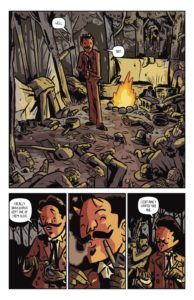 RP: The devil is very gentlemanly and sort of looks like a traditional, old-style villain. How did you approach drawing him, and why choose that representation?
RP: The devil is very gentlemanly and sort of looks like a traditional, old-style villain. How did you approach drawing him, and why choose that representation?
KS: I wanted him to be a Victorian dandy. The devil thinks he’s above all of this; he doesn’t even want to touch the ground because he’s very fancy. I wanted to have what would visually be the fanciest boy. If you google “Victorian dandy”, a specific guy comes up, Robert de Montesquiou, and he’s got the same mustache and the itty, tiny, bitty goatee. It’s this tiny little goatee. It’s so cute.
I have this sort of filthy environment that these characters are going through and these guys are so dirty and he’s so clean. It’s not even good versus evil. Everyone wore suits. Even hobos wore suit jackets in the 40s. Men were expected to wear hats outside. I wanted the devil to be the opposite of them; they’re all roughing it and getting their hands dirty and he’s not. He’s the devil. Like, who gets their hands dirtier than the devil?
RP: Did you go into Rock Candy Mountain with a certain number of issues in mind to tell the story?
KS: I came in with a certain number of issues. I hoped somehow this would be the new Saga or whatever, and Image as a rule is like “don’t say it’s a mini series because then people won’t buy the issues.” That makes sense. As of right now, it’s not Saga, so I will be doing 8 issues. I’m going to tell the exact story I wanted to tell but I’m hoping the trade paperback will get the word of mouth the series didn’t get so maybe I’ll get to do a sequel of sorts.
RS: You were nominated for an Eisner for Sexcastle in 2016 — how has the reception for Rock Candy Mountain been, in comparison? What do you hope the story will bring to the table in the comics industry?
KS: Oh, man, yes! So Sexcastle. I self published it and Matt fraction read it, then told me to talk to Image. Image published it, it was nominated for an Eisner, it was optioned for a movie, and it got me Rick and Morty, which I’ve been writing on for about two years now. That one book has made my career in a bunch of ways.
The plight of Kyle Starks is that everyone who’s read Sexcastle that I’m aware of via social media or review says they like it. Same with Rock Candy Mountain. Everyone who’s read it likes it, but that doesn’t equal more readers, so I’m hoping this conversation we’re having right now will help with that. It’s not about me, it’s about the book, but we’re talking about the book. Historically, whenever I sell a book, I sell 1.5 books. Sexcastle is in its third printing and I know people who have bought it multiple times because they’ll give it away and buy a new one. I hope Rock Candy Mountain is the same.
I’m trying to do something different but not that much different. They’re jokey fight books. Who doesn’t like a jokey fight book? I’m trying to do it in a way that’s sensitive. But I’m trying to bring a fun story that has a little bit more to it. Sexcastle is a fun, jokey book about parental responsibility and men trying to find redemption. A lot of my stories are. That’s an arc of my life, so every book I do I’m like, “oh, I see what’s happening here”
I think comics should be fun and I’m trying to do that in a way that’s not just superheroes or noir mysteries though I would love to do those. I really want to talk about hobos and Kurt Russell movies and expand the genre of comics in America. No one person can do that, but maybe a bunch of us can.
RP: The way you touch on social issues in Rock Candy Mountain is interesting, especially the brief use of a Klan member in Issue 2, who’s quickly shut down by a black man. What’s the importance of those elements and what effect do they have?
KS: Somehow, when I started this book, even America felt different. It was September of last year, before the election. But let me jump ahead for a minute.
Issue #5 comes out in November and it’s a flashback of Jackson’s life. He’s in World War II. I’m putting an unstoppable fighting machine in WWII, so he kills a lot of nazis. This one person just unleashes hell. I didn’t draw the swastika. It’s not in the book. I physically can’t draw that symbol. I asked my colorist, “what should I do? I don’t want to draw it.” So we just left it blank. It’s a white circle. And now I’m concerned that people wil think it’s some kind of alternate history of America thing, but I’m putting in the back of the issue that I won’t draw that thing. I never want to; it disgusts me. Just thinking about it makes me mad.
I’m 40. I don’t want to speak for the voiceless and I don’t think I have the place to because I’m a white man. I’m a white man. But these things are important to me because we live in a world today where these things should be important to everybody.
If I wrote issue #2 today, I don’t think I would write that KKK character in because of what is literally happening right now today. But Hundred Cat — you’re the world’s toughest African American street-fighter-slash-cat-burglar, you get to do whatever the hell you want. And that other guy realizes in that moment that if you’re a terrible person, then terrible things will happen to you.
My whole thing is I think everyone should be decent! These people exist in the world. Comics are made by who? Like 80 percent white men, right? That’s garbage that we’re only writing about white men. The line exists that I can’t write about certain experiences no matter how good of a writer I am. I think everyone should be represented but it’s difficult. Comics are bad. There should be less white people being shitty in comics.
Oni is doing really well with that. They have a really diverse editorial board and they’re trying to make books that are for everybody, which is great. But it’s a matter of why would anyone end up getting into this industry? There’s no money in comics, either. It’s just bad.
RP: Are you the type of creator who only consumes media related to your current project, or do you tend to just consume everything all at once, regardless?
KS: I recently read that after a certain age in the 30s, your brain quits growing. You reach the point of maximum hard drive space and I feel like that’s very, very true. I’m trying to read again. Mostly, when you make comics, there’s always something going in the background that you’re not really paying attention to. Consuming media now isn’t as exciting as it once was.
Like, have you watched The Expanse? A friend recommended it to me and the commercials looked like garbage but I did it because I respect that person’s opinion. And I just blew through it. It was surprisingly good for a sci-fi show and I try to ingest a lot of sci-fi because of Rick and Morty. The sci-fi I want to watch is like… Arnold Schwarzenegger sci-fi, but that isn’t current. That won’t help me.
Ingesting pop culture once you’re in a position where you contribute to it is weird. Right now, I’m finishing up this book and drawing this book is what I’m totally into. I just came back from a convention with like $350 worth of board games that I’m stoked about, but will never get to play because I don’t have friends.
If something’s wildly popular, I want to ingest it to see why it is and also because I think I’ll find something to get excited about. Because of that, I’ve read a lot of really bad stuff.
RP: Is there anything else you’d like to add?
KS: One of the biggest problems I had with doing this story, dealing specifically with hobos on trains… that’s basically a 100 percent male endeavor. Realistically, there were female hobos, but it was a really small percentage. Toward the end of Rock Candy Mountain, I get this opportunity, but other than that I didn’t really get a chance to put female characters in other than Black Orchid, who’s the head of the fight ring.
I wanted Jackson to be pursued by multiple groups who were high stakes. When making the book I wanted to have female characters. My two favorite characters are Hundred Cat and Babs Bardoux. In the second half of the arc, they get to breathe a lot more. He’s in prison, which is problematic, but he gets a lot more space. So for anyone who read the first arc and wanted more from either of them, it’s coming and it’s awesome.
The first four issues set up the next four. We set up the journey and now we’re going to end it. I think if people read Rock Candy Mountain, then they’ll like it. It’s a book that I hope has legs for a long time because it’s really fun and I think humans need fun.
And then there’s a bunch of stuff coming up that I could talk about, but we’re talking about Rock Candy Mountain.
RP: I mean, you can talk about that. Our readers would probably like the info.
KS: Okay, so I’ve got a new book through Oni Press called Kill Them All coming in September. I think it’s the same release day as Rock Candy Mountain. Maybe they’re a week apart? Then I’ve also got Dead of Winter and Rick and Morty new issues coming. There will be a month where I’ll have four books on the shelf which is really wild for me.
For bonus material from this interview, support Rogues Portal on Patreon for just $1 per month! Pre-order Rock Candy Mountain Vol. 1 via Image Comics or get it in stores September 27. To keep up with Kyle Starks, follow him on Twitter.


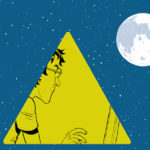
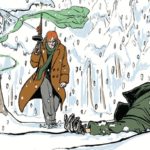
2 thoughts on “Interview: Talking Rock Candy Mountain with Kyle Starks”